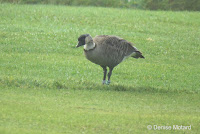NENE (Branta sandvicensis) – (See images below)
DESCRIPTION: The Nēnē is a medium size goose with a black head, nape and bill, and oblique black and white furrows on the neck, with the white predominant at both ends. The breast is grey and the under parts finely barred with grey. The back is darker grey with the feathers edged in white. The tail is dark grey and the rump is white. The legs and feet are black. Sexes are similar. The bird is around 25 inches (63 cm) long. The bird is sedentary but can fly well enough within the same island.
VOICE: https://www.xeno-canto.org/species/Branta-sandvicensis
NAME: The Nēnē (or Hawaiian Goose) derives it Hawaiian name from its soft call. The Latin genus name ‘Branta’ comes from Old English and Old Norse and means ‘burnt’, in reference to the dark plumage of the bird. The Latin species name ‘sandvicensis’ refers to the former name of the Hawaiian Islands, the
Sandwich Islands.
HABITAT: Can vary from lowlands with thick vegetation to scrubland, grass fields and golf courses. Nēnēs frequent more lava fields with sparse vegetation than wetlands, so their feet evolved accordingly and are only partially webbed.
DIET: Plant material such as seeds, leaves, berries, flowers.
NESTING: Nēnēs are monogamous and mate for life. They breed most of the year but winter is the peak mating season. The nest is built under thick vegetation and lined with down. About 3-4 white eggs are laid. Goslings can’t fly until three months old.
DISTRIBUTION: Endemic to Hawaii and found only on Kauai, Maui and the Big Island. Bred in zoos around the world.
CONSERVATION: The nēnē is the world’s rarest goose, having gone down to a population of only 30 in 1952. However this bird breeds well in captivity and there are now around 1,000 individuals in zoos around the world. Thanks to conservation efforts, the wild population has rebounded to around 800 birds. But the nēnē is still vulnerable to introduced feral predators such as mongoose, pigs and cats, because it nests on the ground. There is also mortality from road accidents (hence the signs seen below), as they’re the same color as the road and walk slowly, and often some of their habitat is foggy so they’re hard to see.
NOTES: The nēnē is endemic to Hawaii, and it is the
state bird. DNA analysis has shown that the nēnē evolved from the
Canada goose over hundreds of thousands of years. (There are still some Canada geese that will show up in Hawaii during their yearly migration.) At some point in the past, there was also the
giant nēnē, but it is now extinct.
SIMILAR SPECIES: Canada Goose
REFERENCES: https://en.wikipedia.org/wiki/Nene_(bird
Fact sheet from Hawaii Department of Land and Natural Resources:
Nene – Hawaii DLNR – Oct. 2005
https://greenglobaltravel.com/hawaiian-goose-facts-nene-goose/
http://www.ducks.org/hunting/waterfowl-id/hawaiian-nene-goose
 |
| The Nene is the State Bird of Hawaii |
 |
| Nene at the Honolulu Zoo |
 |
| Nene became almost extinct |
 |
| Controlling predators is necessary |
 |
| Nenes descend from the Canada Goose |
 |
| Looking up, Volcano Golf Course |
The Nene with the number 31 band on the Volcano Golf Course is "No. 831, a 9 year old male. He hatched in Hawaii Volcanoes National Park, resides in the Volcano area year round, frequenting areas both within and adjacent to the park." This is the answer I got from USFWS, Pacific Islands Fish and Wildlife Office when I inquired about the bird band number.
 |
| Nene male No. 831, 9 years old |
 |
| Nene No. 831 foraging, Volcano |
 |
| No. 831 on Volcano Golf Course, HI |
 |
| Nene habitat, Hawaii Volcanoes NP |
 |
| Nene crossing |










